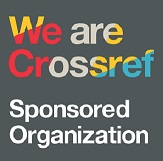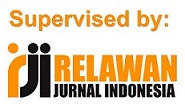IMPLEMENTASI PEMBELAJARAN MANDIRI UNTUK MENINGKATKAN KEMAMPUAN PEMECAHAN MASALAH PADA MATA KULIAH KALKULUS INTEGRAL
Abstract
Keywords
Full Text:
PDF (Bahasa Indonesia)References
Aprillia, U. D., Syahlan, & Hasratuddin. (2020). Pengaruh contextual teaching and learning terhadap kemampuan komunikasi dan disposisi matematis mahasiswa SMA Negeri 04 Tebing Tinggi. MAJU: Jurnal Pendidikan Matematika, 7(1).
Arofah, M. N., & Noordyana, M. A. (2021). Kemampuan Pemecahan Masalah Matematis Ditinjau dari Kemandirian Belajar Siswa pada Materi Lingkaran di Kelurahan Muarasanding. Plusminus: Jurnal Pendidikan Matematika, 1(3), 421-434
Chen, L., Yoshimatsu, N., Goda, Y., Okubo, F., Taniguchi, Y., Oi, M., ... & Yamada, M. (2019). Direction of collaborative problem solving-based STEM learning by learning analytics approach. Research and Practice in Technology Enhanced Learning, 14(1), 1-28.
Damayanti, N., & Kartini, K. (2022). Analisis Kemampuan Pemecahan Masalah Matematis Siswa SMA pada Materi Barisan dan Deret Geometri. Mosharafa: Jurnal Pendidikan Matematika, 11(1), 107-118.
Handayani, L., Nyoman, N., Dantes, N., & Suastra, I. W. (2013). Pengaruh Model Pembelajaran Mandiri terhadap Kemandirian Belajar dan Prestasi Belajar IPA Mahasiswa Kelas VIII SMP N 3 Singaraja. Ganesha University of Education.
Hanifah, H. R. F. N., & Nuraeni, R. (2020). Perbedaan peningkatan kemampuan pemecahan masalah matematis siswa antara think pair share dan think talk write. Mosharafa: Jurnal Pendidikan Matematika, 9(1), 155-166
Ike Natalliasari & Eva Mulyani. (2017). Implementasi pembelajaran investigasi berbantuan Software Cabri 3D terhadap kemampuan pemecahan masalah matematis dan kemandirian belajar mahasiswa. Jurnal Penelitian Pendidikan dan Pengajaran Matematika, 3(1).
Lestari, P., & Rosdiana, R. (2018). Kemampuan Pemecahan Masalah Matematis Siswa melalui Model Pembelajaran Learning Cycle 7E dan Problem Based Learning. Mosharafa: Jurnal Pendidikan Matematika, 7(3), 425-432.
Mudjiman, Haris. (2008). Belajar Mandiri. Surakarta: UNS Press.
Mulyati, T. (2016). Kemampuan Pemecahan Masalah Matematis Siswa Sekolah Dasar. Jurnal Pendidikan, 1(7), 1-5.
Novitasari, & Hestu, W. (2018). Analisis Kemampuan Pemecahan Masalah Matematika Siswa SMP Negeri 10 Tangerang. Prima: Jurnal Pendidikan Matematika, 2(2), 137-147.
Nuriana R. Dewi dkk. (2020). Kemampuan Pemecahan Masalah Matematis Mahasiswa pada Pembelajaran Preprospec Berbantuan TIK. Jurnal Matematika Kreatif-Inovatif, 11(2)
Purcell dan Vanberg. (2000). Kalkulus dan Geometri Analitik, Jilid 1. Jakarta : Erlangga
Trisiana, A. (2015). Optimalisasi Belajar Mandiri Tata Pamong (Tinjauan Kritis dan Pengembangan Terhadap Peningkatan Kualitas Sumber Daya Manusia yang Berkarakter). Widya Wacana: Jurnal Ilmiah, 9(2).
Soekisno, B. A. (2002). Kemampuan pemecahan masalah matematika siswa dengan strategi Heustrik. Bandung: Tesis pada jurusan Pendidikan Matematika Universitas Pendidikan Indonesia. Tidak diterbitkan.
Sriwahyuni, K., & Maryati, I. (2022). Kemampuan Pemecahan Masalah Matematis Siswa pada Materi Statistika. Plusminus: Jurnal Pendidikan Matematika, 2(2), 335–344. https://doi.org/10.31980/plusminus.v2i2.1830
Ulandari, L., Amry, Z., & Saragih, S. (2019). Development of Learning Materials Based on Realistic Mathematics Education Approach to Improve Students' Mathematical Problem Solving Ability and Self-Efficacy. International Electronic Journal of Mathematics Education, 14(2), 375-383.
Xu, C., Lafay, A., Douglas, H., Di Lonardo Burr, S., LeFevre, J. A., Osana, H. P., ... & Maloney, E. A. (2022). The role of mathematical language skills in arithmetic fluency and word-problem solving for first-and second-language learners. Journal of Educational Psychology, 114(3), 513.
DOI: https://doi.org/10.30743/mes.v8i2.7573
Refbacks
- There are currently no refbacks.

.png)

